- Aleph
- Anna Gat
- Ariel LeBeau
- Austin Robey
- David Blumenstein
- David Ehrlichman
- David Kerr
- Devon Moore
- Dexter Tortoriello
- Drew Coffman
- Drew Millard
- Eileen Isagon Skyers
- FWB Staff
- Gaby Goldberg
- Greg Bresnitz
- Greta Rainbow
- Ian Rogers
- Jessica Klein
- Jose Fernandez da Ponte
- Jose Mejia
- Kelani Nichole
- Kelsie Nabben
- Kevin Munger
- Khalila Douze
- Kinjal Shah
- Kyla Scanlon
- LUKSO
- Lindsay Howard
- Maelstrom
- Marc Moglen
- Marvin Lin
- Mary Carreon
- Matt Newberg
- Mike Pearl
- Mike Sunda (PUSH)
- Moyosore Briggs
- Nicole Froio
- Ruby Justice Thelot
- Ryne Saxe
- Simon Hudson
- Steph Alinsug
- The Blockchain Socialist
- Willa Köerner
- Yana Sosnovskaya
- Yancey Strickler
- iz

Tue Dec 03 2024
Every now and then, we hit a shift in technology that changes everything. The internet did it, open-source software did it, and now blockchains are doing it. At first glance, people ask the same question they always do: “Why do we need this when the old system still works?” But if you dig deeper, it becomes clear that the old systems have cracks—they’ve been optimized for the past, not for the future we’re building.
Blockchains offer a fundamentally new way to build systems that are more open, more inclusive, and more efficient. At their core, they lower transaction costs—the hidden frictions that slow down innovation and lock out new participants. These costs are embedded in everything we do today, from making payments to creating content to running social networks. But the good news is, blockchains can help eliminate many of them. And when you reduce transaction costs, innovation unlocks: new markets emerge, people are empowered to build, and systems become more democratic.
In this piece, I’m going to talk about why decentralization matters in a very practical sense, as a means not an end; how blockchains are the next logical step in the evolution of the internet; and what that means for the future of how we create, share, and transact.
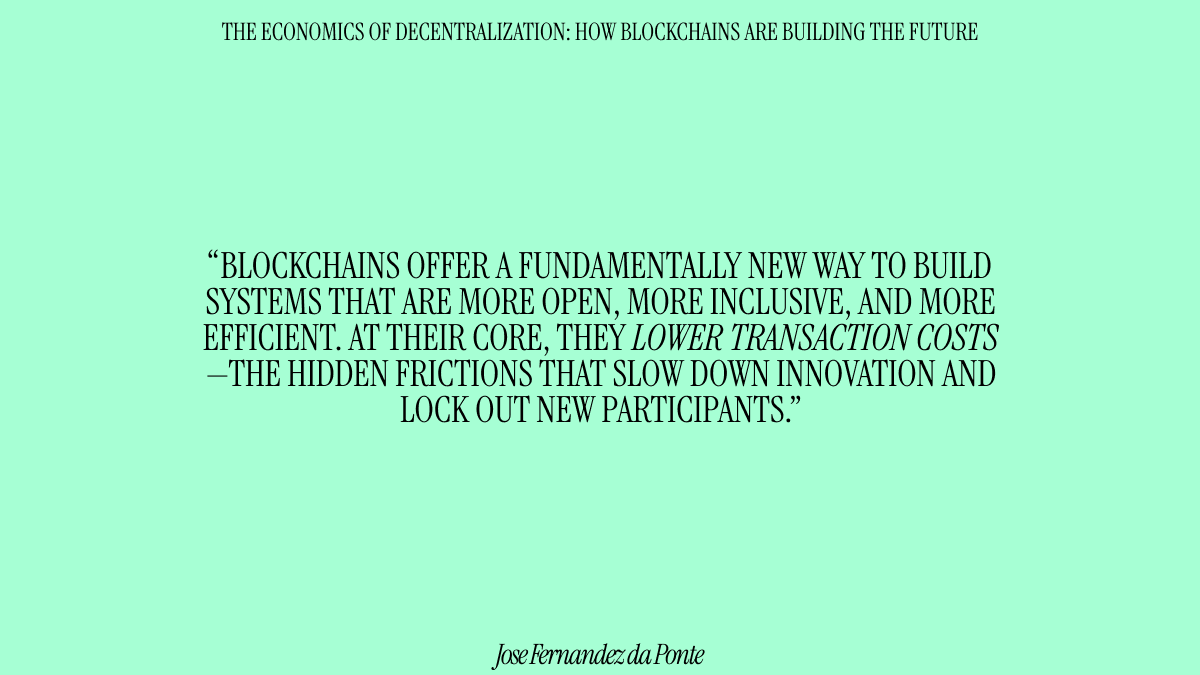
Why Centralization Works—Until It Doesn’t
First, let’s talk about why centralized systems exist in the first place. It comes down to transaction costs—the costs of finding information, negotiating deals, and enforcing agreements. Large organizations, like corporations or banks, emerge because they lower these costs. They handle all the complexity and friction at scale.
But centralization has its limits. While it reduces some costs, it can create new problems. If unchecked, it can lock in power and it can lead to excessive concentration. And if a small number of players control everything, innovation slows down. The same companies that were once disruptors can become incumbents focused on protecting their turf.
Decentralization flips that script, when a system can run at lower transaction costs without concentrating power. When systems are open and permissionless, anyone can build on top of them, just like developers did with the early internet. That’s where blockchains come in—they enable a new wave of innovation by removing the need for central gatekeepers and allowing people to interact directly, securely, and at scale at a fraction of the cost.
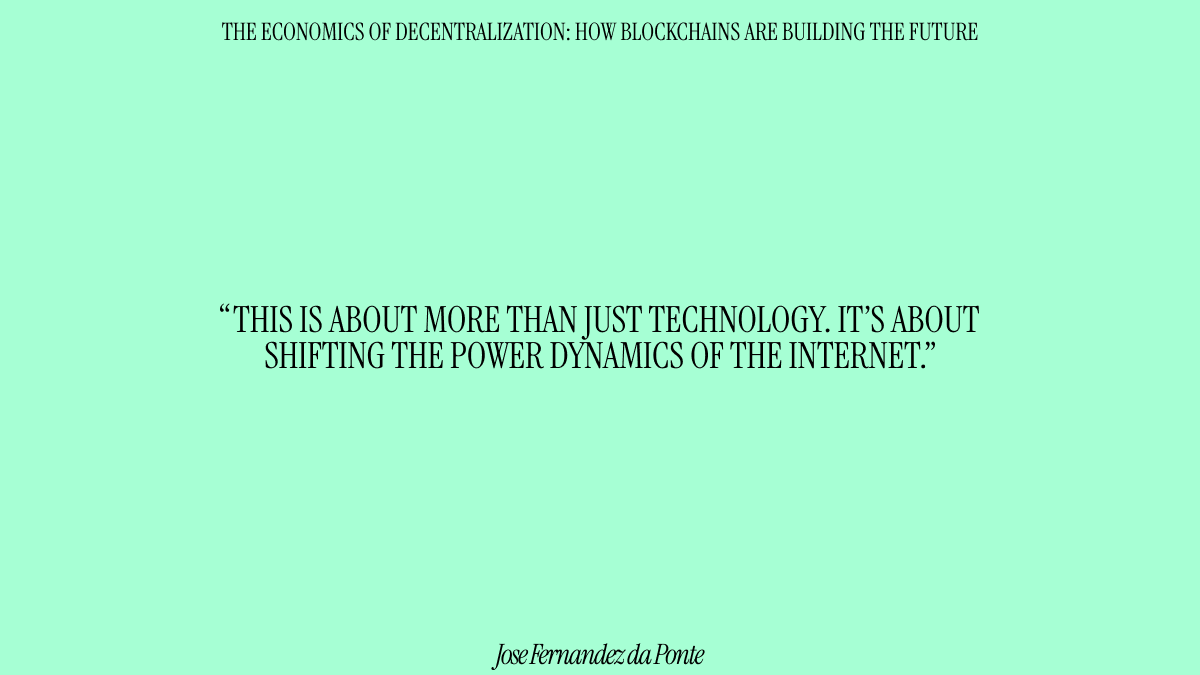
Blockchains as a New Platform for Builders
So why are blockchains different? Blockchains don’t just replicate old systems—they offer a fundamentally new way to build. At the heart of this is the idea of lowering transaction costs.
Here’s how blockchains make it happen:
- Trustless Networks: In traditional systems, you need intermediaries to establish trust. When you pay someone, a bank verifies the transaction. When you sign a contract, a lawyer enforces it. Blockchains cut out the middleman by using decentralized networks where consensus is achieved automatically. This reduces the cost of doing business and makes the system more open.
- Smart Contracts: Blockchains enable smart contracts, which are self-executing programs that remove the need for third parties. Once certain conditions are met, the contract automatically enforces itself. This cuts down on legal costs, negotiation time, and complexity, allowing smaller, more frequent interactions to still be economical.
- Transparency and Ownership: Blockchains give users control over their own data and assets. Everything is transparent and verifiable on the blockchain, meaning users no longer need to trust centralized platforms to handle their data. This shifts power back to individuals, creating a more user-owned network.
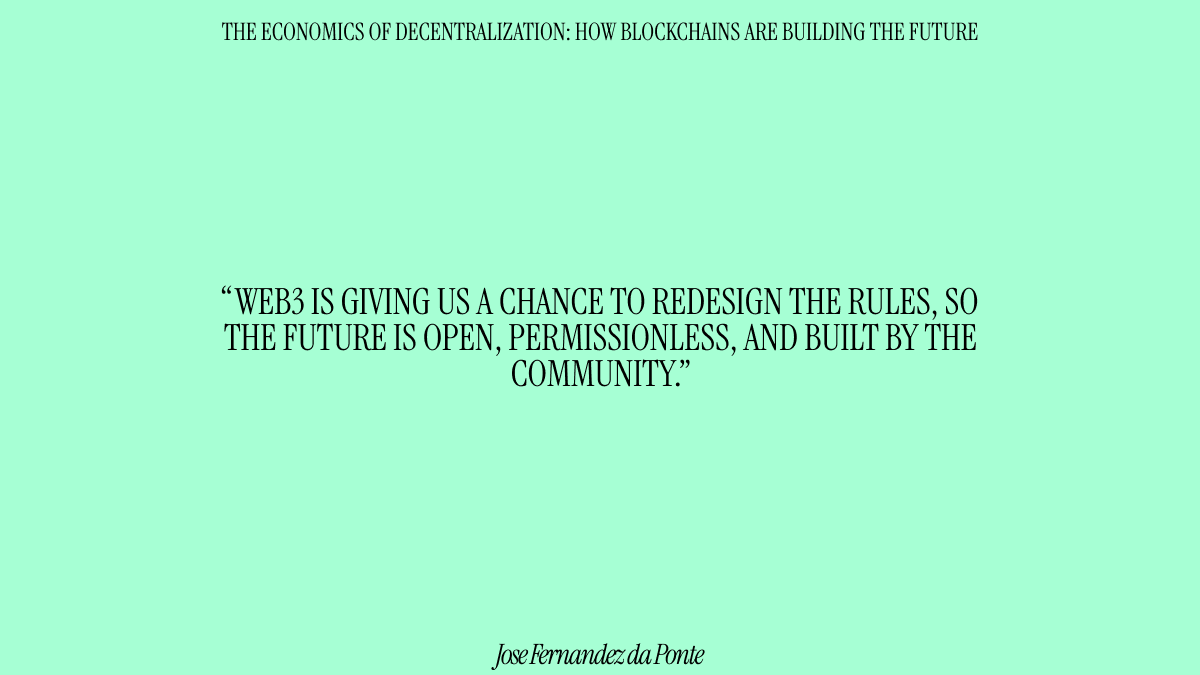
What This Means for the Future of Innovation
When transaction costs drop, we see a push to decentralization and an explosion of innovation. This has already started to happen across industries.
- Payments The traditional payment system is built on 50 years old infrastructure. It’s slow and expensive, and still has barriers to access. Blockchains offer a solution that’s faster, cheaper, and more inclusive. Stablecoins and decentralized payment networks can move money across borders in seconds for pennies. This isn’t just an incremental improvement—it’s a complete redesign of how money moves. Imagine a world where payments settle instantly, 24/7, with minimal fees. That world is being built right now.
- Social Networks Today’s social networks keep users inside walled gardens. With blockchain-based platforms like Farcaster and Nostr, users can own their data and move freely between networks. This shifts power from platforms back to users and unlocks entirely new business models where creators can capture more value.
- Telecommunications Decentralized models like Helium are transforming telecom by letting anyone with a wireless hotspot participate in a decentralized network and get paid for it. This democratizes access and reduces the costs of building large-scale networks.
- Content Creation Platforms like Mirror and Paragraph are building the future of content creation by allowing creators to publish and monetize their work without relying on centralized platforms. This gives creators more control and ownership, while reducing the fees and middlemen that typically take a cut of their earnings. The result? A more creator-friendly internet.
For Creators and Builders
The most exciting part about decentralization is its practical outcome: it gives power back to the people who are building and creating. From a system based on platforms, creators and builders can now own their work, set their own terms, and capture more of the value they create.
This is about more than just technology. It’s about shifting the power dynamics of the internet. Web3 is giving us a chance to redesign the rules, so the future is open, permissionless, and built by the community.
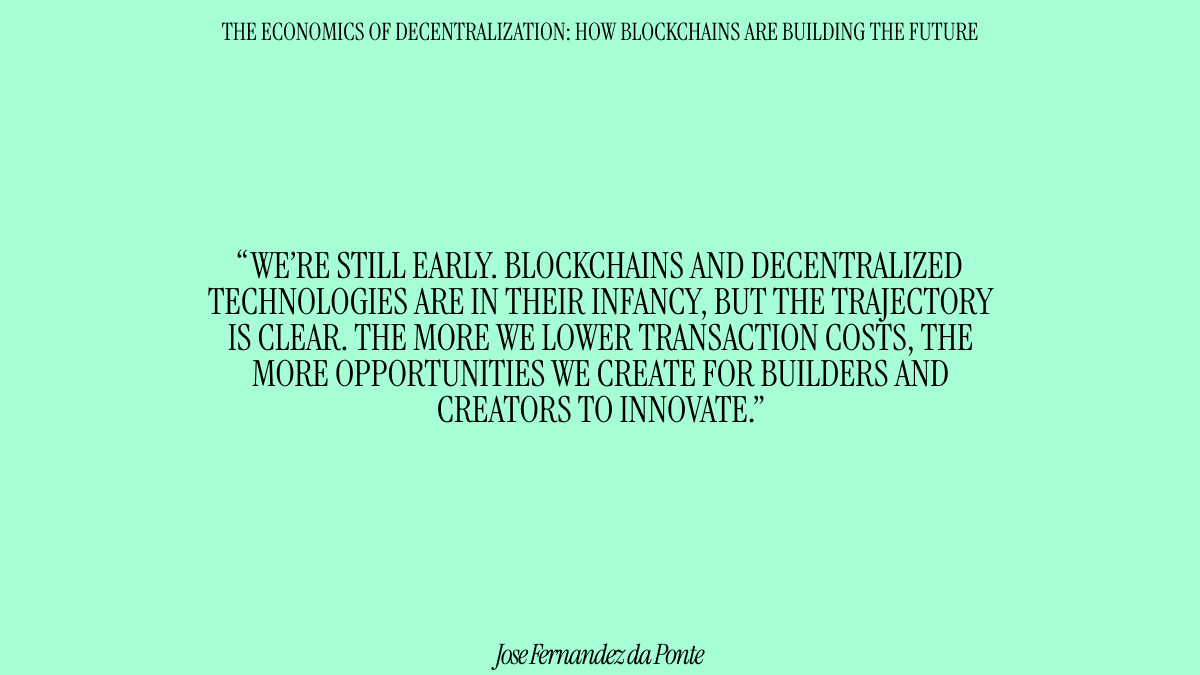
A More Inclusive Future
Decentralization isn’t just about cost savings—it’s about inclusion. Today’s centralized systems don’t serve everyone equally. There are people who don’t have access to banking services or live in areas without reliable infrastructure. Blockchains can help close that gap.
Take payments again as an example. We’re seeing blockchain-based solutions being used in crisis zones, where traditional infrastructure fails. The United Nations has used stablecoins on the Stellar blockchain to send aid directly to refugees. We see people send money to their loved ones back home straight from their Venmo wallets to stablecoin-enabled wallets at substantially better cost making their funds go further. We have talked to SMBs that are increasingly using stablecoins for B2B payments across borders. And we are starting to see many cases that abstract complexity from users, building a familiar fiat money experience on top of blockchain settlement infrastructure as the path for mainstream adoption.
The Path Forward: Why We Need to Keep Building
We’re still early. Blockchains and decentralized technologies are in their infancy, but the trajectory is clear. The more we lower transaction costs, the more opportunities we create for builders and creators to innovate. Just like the early days of the internet, the potential here is enormous.
But the challenge, as always, is to keep building and build responsibly. The more open we make these systems, the more inclusive and dynamic the internet becomes. And this isn’t about technology for the sake of technology—it’s about creating a future where anyone, anywhere, can participate, build, and create while balancing efficiency with smart governance and regulation.
The future of decentralization is more than just a technological shift—it’s a chance to reshape how we interact, do business, and build a more inclusive world. By reducing transaction costs, blockchains unlock new possibilities, enabling people and businesses to participate in a system that is fairer, faster, and more open.
This is about creating a future where systems aren’t just efficient—they’re accessible, inclusive, and built for everyone. And we’re just getting started.
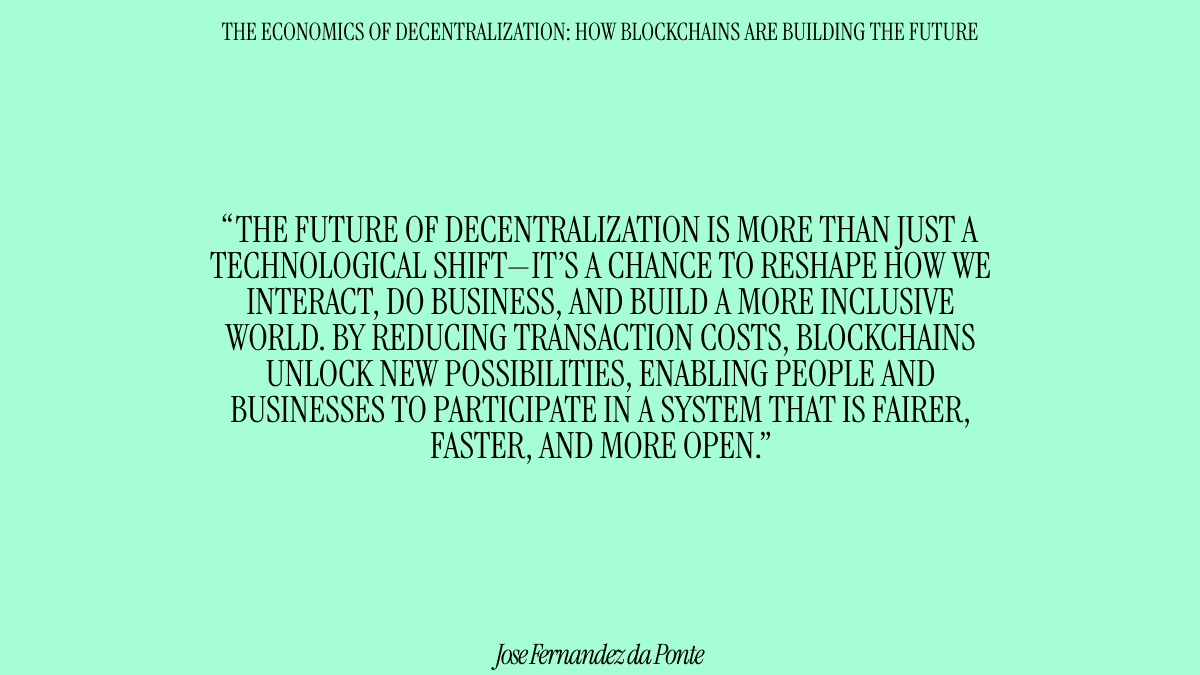
About the series: Checking in on Squad Wealth is a 4-part editorial series investigating the path toward a blockchain-dominant future, where financial tools are intertwined with cultural narratives.
With essays by a storied cast of eminent culture and finance experts including Anna Gát, Gaby Goldberg, and Jose Fernandez da Ponte, and Kyla Scanlon.


